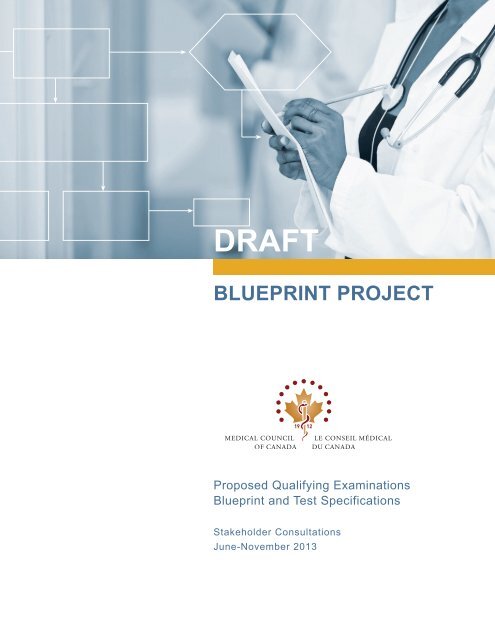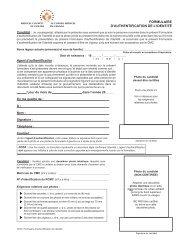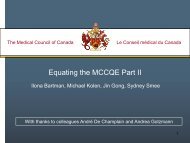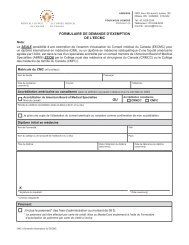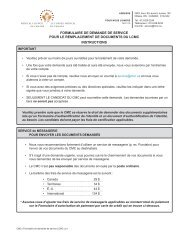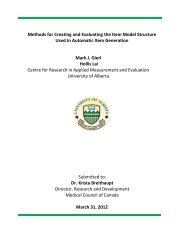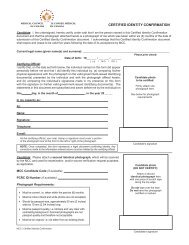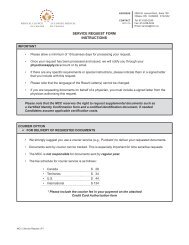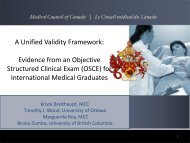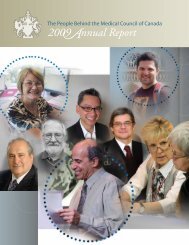Blueprint and Test Specifications report - Medical Council of Canada
Blueprint and Test Specifications report - Medical Council of Canada
Blueprint and Test Specifications report - Medical Council of Canada
You also want an ePaper? Increase the reach of your titles
YUMPU automatically turns print PDFs into web optimized ePapers that Google loves.
1DRAFTBLUEPRINT PROJECTProposed Qualifying Examinations<strong>Blueprint</strong> <strong>and</strong> <strong>Test</strong> <strong>Specifications</strong>Stakeholder ConsultationsJune-November 2013
2BLUEPRINT PROJECTTHE MEDICAL COUNCIL OF CANADAstrives to achieve the highest level <strong>of</strong>medical care for Canadians throughexcellence in evaluation <strong>of</strong> physicians.The <strong>Council</strong> assesses over 11,000 medicalstudents <strong>and</strong> graduates every year throughits examinations.As part <strong>of</strong> the Assessment Review TaskForce recommendations, the MCCundertook a strategic review <strong>of</strong> itsassessment processes with a clear focuson their purposes <strong>and</strong> objectives, theirstructure <strong>and</strong> their alignment with MCC’smajor stakeholder requirements. The reviewencompassed current trends in medicaleducation, regulation <strong>and</strong> assessment.The review also took into account therole <strong>and</strong> purpose <strong>of</strong> MCC examinations inmeeting the current <strong>and</strong> future needs <strong>of</strong>MRAs, the public <strong>and</strong> other stakeholders.Multi-stakeholder consultation <strong>and</strong> analysisactivities were conducted between 2009 <strong>and</strong>2011 with resulting recommendations <strong>and</strong><strong>report</strong> approved by <strong>Council</strong> in 2011.In addition to recommendations to focuson MCC’s reassessment <strong>and</strong> realignment<strong>of</strong> exams, a key recommendation was tovalidate <strong>and</strong> update the blueprints for allMCC qualifying examinations.As part <strong>of</strong> its commitment to adhere tobest practices in medical education <strong>and</strong>assessment, the MCC has undertaken a<strong>Blueprint</strong> Project to review <strong>and</strong> establishan evidence-based approach for identifyingthe competencies that physicians will beexpected to demonstrate <strong>and</strong> be assessedon at two decision points: (1) entry intosupervised practice (residency), <strong>and</strong> (2)entry into unsupervised practice. Thepurpose <strong>of</strong> the MCC <strong>Blueprint</strong> Project is topromote assessments that assure the publicthat physicians licensed to practice medicinehave the required knowledge, skills <strong>and</strong>behaviours for safe <strong>and</strong> effective patientcare.DRAFT
BLUEPRINT PROJECT3Defining the MCCAssessment <strong>Blueprint</strong>Over the past 18 months, work has been undertaken to set the stage to validate <strong>and</strong> update the MCCqualifying examination blueprints. With the establishment <strong>of</strong> a multi-stakeholder governance board, aproject steering committee, <strong>and</strong> a MCC project team, work proceeded with defining an evidence-based <strong>and</strong>consultative approach to establish the blueprints.Gathering <strong>and</strong> Analyzing DataTo facilitate the task <strong>and</strong> inform the MCC Assessment <strong>Blueprint</strong>, evidence was provided through a series <strong>of</strong><strong>report</strong>s that highlight various facets <strong>of</strong> physician practice <strong>and</strong> assessment:• Report <strong>of</strong> the National Survey <strong>of</strong> thePhysicians, Pharmacists, Nurses, <strong>and</strong> Publicin <strong>Canada</strong>: 2013 - Explored the relativeimportance <strong>of</strong> physician knowledge, skills<strong>and</strong> behaviours expected <strong>of</strong> physicians at thetwo decisions points – entry into supervisedpractice <strong>and</strong> entry into unsupervised practice.The National Survey was designed aroundthe CanMEDS roles 1 as per our presentobjectives.• Report <strong>of</strong> Incidence <strong>and</strong> Prevalence <strong>of</strong>Diseases <strong>and</strong> Other Health Related Issuesin <strong>Canada</strong> - Highlights prevalent conditionsthat should be “covered” in medical licensingexaminations to ensure that doctors areadequately prepared to treat today’sCanadian population’s major health concernsas well as other areas <strong>of</strong> importance suchas population health, care <strong>of</strong> the elderly,aboriginal issues <strong>and</strong> patient safety.• Report on the Supervision <strong>of</strong> New PGY-1Residents: A Case Report <strong>of</strong> SupervisorsExpectations vs. Residents’ Perceptionsproject - Defined entrustable pr<strong>of</strong>essionalactivities to <strong>of</strong>fer perspectives on the levels<strong>of</strong> supervision early in the postgraduate-yearone <strong>of</strong> residency. This <strong>report</strong> helped frameexpectations at the two decision points:entry into supervised practice <strong>and</strong> entry intounsupervised practice.• Report to the <strong>Medical</strong> <strong>Council</strong> <strong>of</strong> <strong>Canada</strong> onCurrent Issues in Health Pr<strong>of</strong>essional <strong>and</strong>Health Pr<strong>of</strong>essional Trainee Assessment -Offers insight <strong>and</strong> perspectives into ways inwhich the MCC might consider adapting itscurrent assessment practices <strong>and</strong> developingadditional tools to align with modern <strong>and</strong>future conceptions <strong>of</strong> medical education <strong>and</strong>medical practice.These <strong>report</strong>s, as summarized in Appendix A, <strong>of</strong>fered perspectives on the importance <strong>of</strong> competencies,frequencies <strong>of</strong> clinical presentations, possible entrustable pr<strong>of</strong>essional activities, <strong>and</strong> finally thoughts on thecurrent <strong>and</strong> future vision <strong>of</strong> assessment.[1]Frank, JR., Jabbour, M., et al. Eds. (2005). Report <strong>of</strong> the CanMEDSPhase IV Working Groups. Ottawa: The Royal College <strong>of</strong> Physicians<strong>and</strong> Surgeons <strong>of</strong> <strong>Canada</strong>DRAFT
BLUEPRINT PROJECT4Defining the <strong>Blueprint</strong> <strong>and</strong><strong>Specifications</strong> for AssessmentsIn defining the blueprint <strong>and</strong> test specifications for assessments, MCC invited twelve physician subjectmatter experts (SMEs) to provide judgments concerning the content that should be assessed at the twodecision points. The subject matter experts brought various viewpoints to the blueprint definition including:• MCC <strong>Council</strong> –with MRA <strong>and</strong> University representatives• Certification bodies –RCPSC <strong>and</strong> CFPC representatives• Internal MCC Committees –Central Examination Committee,Objectives Committee <strong>and</strong> <strong>Test</strong> Committeerepresentatives• <strong>Medical</strong> Education –UGME <strong>and</strong> PGME Deans representativesA three-day workshop was held in mid-May 2013 to seek consensus <strong>and</strong> a recommendation for a blueprint<strong>and</strong> test specifications for MCC qualifying examinations.Recommended <strong>Blueprint</strong> <strong>and</strong> <strong>Test</strong> <strong>Specifications</strong> -Themes <strong>and</strong> OutcomesThe physician subject matter expert (SME) panel were able to reach agreement in describing the c<strong>and</strong>idates<strong>and</strong> in identifying a common assessment blueprint. <strong>Test</strong> specifications were proposed for c<strong>and</strong>idates at twodecision points – entry into supervised practice <strong>and</strong> entry into unsupervised practice.The proposed blueprint consists <strong>of</strong> two broad domains each broken down into four sections (Appendix B).Dimensions <strong>of</strong> Care 2Focus <strong>of</strong> care for the patient, family, community <strong>and</strong>/or population• Health Promotion <strong>and</strong> Illness PreventionThe process <strong>of</strong> enabling people to increasecontrol over their health <strong>and</strong> its determinants,<strong>and</strong> thereby improve their health. Illnessprevention covers measures not only to preventthe occurrence <strong>of</strong> illness, such as risk factorreduction, but also to arrest its progress <strong>and</strong>reduce its consequences once established 3 .This includes, but is not limited to screening,periodic health exam, health maintenance,patient education <strong>and</strong> advocacy, <strong>and</strong>community <strong>and</strong> population health.[2]Modified from Wengh<strong>of</strong>er, E.F., Williams, A.P., Klass, D.J., Faulkner, D.Physician-Patient Encounters: The Structure <strong>of</strong> Performance in Family <strong>and</strong>General Office Practice. J Cont Educ Health Pr<strong>of</strong> 2006; 26:285-293.[3]World Health Organization, www.who.int/chp/en accessed 14/05/2013DRAFT
BLUEPRINT PROJECT5• AcuteBrief episode <strong>of</strong> illness within the time sp<strong>and</strong>efined by initial presentation through totransition <strong>of</strong> care. This dimension includes butis not limited to urgent, emergent, <strong>and</strong> lifethreateningconditions, new conditions, <strong>and</strong>exacerbation <strong>of</strong> underlying conditions.• ChronicIllness <strong>of</strong> long duration that includes but isnot limited to illnesses with slow progression.• Psychosocial AspectsPresentations rooted in the social <strong>and</strong>psychological determinants <strong>of</strong> health thatinclude but are not limited to life challenges,income, culture, <strong>and</strong> the impact <strong>of</strong> thepatient’s social <strong>and</strong> physical environment.Physician ActivitiesReflects the scope <strong>of</strong> practice <strong>and</strong> behaviors <strong>of</strong> a physician practicing in <strong>Canada</strong>• Assessment/ DiagnosisExploration <strong>of</strong> illness <strong>and</strong> disease throughgathering, interpreting <strong>and</strong> synthesizingrelevant information that includes but is notlimited to history taking, physical examination<strong>and</strong> investigation.• ManagementProcess that includes but is not limitedto generating, planning, organizing carein collaboration with patients, families,communities, populations, <strong>and</strong> health carepr<strong>of</strong>essionals (e.g., finding common ground,agreeing on problems <strong>and</strong> goals <strong>of</strong> care, time<strong>and</strong> resource management, roles to arrive atmutual decisions for treatment).• CommunicationInteractions with patients, families, caregivers,other pr<strong>of</strong>essionals, communities <strong>and</strong>populations. Elements include but arenot limited to active listening, relationshipdevelopment, education, verbal, non-verbal<strong>and</strong> written communication (e.g., patientcentered interview, disclosure <strong>of</strong> error,informed consent).• Pr<strong>of</strong>essional BehaviorsAttitudes, knowledge, <strong>and</strong> skills basedon clinical <strong>and</strong>/or medical administrativecompetence, communication skills, ethics,societal, <strong>and</strong> legal duties resulting in the wiseapplication <strong>of</strong> behaviors that demonstrate acommitment to excellence, respect, integrity,empathy, accountability <strong>and</strong> altruism. (e.g.,self-awareness, reflection, life-long learning,scholarly habits <strong>and</strong> physician health forsustainable practice).These blueprint domains were thought to reflect practice that can be assessed not only at both qualifyingexamination decision points but also could be applied to any physician in any practice. This blueprint reflectsknowledge, skills <strong>and</strong> behaviors that all physicians practicing in <strong>Canada</strong> should demonstrate when takingcare <strong>of</strong> patients, families, communities <strong>and</strong> the population at large. Principles <strong>of</strong> patient safety underscoreeach <strong>of</strong> the dimensions. These dimensions can also be mapped to the CanMEDS roles with many rolesrepresented in many “boxes” within the 2 x 2 table.DRAFT
BLUEPRINT PROJECT6<strong>Test</strong> specifications<strong>Test</strong> specifications are guidelines about how to sample each domain that is being assessed. The SMEshave proposed test specifications for each <strong>of</strong> the two decision points; entering supervised practice <strong>and</strong>entering unsupervised practice. Although all categories should be assessed at each decision point,differences do exist to emphasize certain areas. The test specifications propose that both the dimensions<strong>of</strong> Communications <strong>and</strong> Pr<strong>of</strong>essional Behaviors should have significant weight at both decision points.As well, the proposed specifications place slightly more emphasis on the Acute dimension <strong>of</strong> care <strong>and</strong>the Assessment/Diagnosis activity for assessing physicians at the first decision point, readiness to entersupervised practice (Appendix C); whereas the emphasis is more on the Chronic dimension <strong>of</strong> care <strong>and</strong> theManagement activity for the second decision point, readiness to enter unsupervised practice (Appendix D).Approval-in-PrincipleBased on the recommendations from the physician subject matter expert panel in mid-May, the CentralExamination Committee (CEC) met on June 11, 2013 to review the proposed blueprint <strong>and</strong> test specifications.The CEC accepted a motion for approval-in-principle <strong>of</strong> the blueprint <strong>and</strong> test specifications that included abroad stakeholder consultation process.NEXT STEPSAs part <strong>of</strong> the consultation process, the MCC will reach out to engage various external stakeholderorganizations <strong>and</strong> internal stakeholder committees in a transparent manner to provide them with theopportunity to comment on the proposed MCC <strong>Blueprint</strong> <strong>and</strong> <strong>Test</strong> <strong>Specifications</strong>.If your organization wishes to have the opportunity to comment, please contact Dr. Claire Touchie atctouchie@mcc.ca. The MCC would be pleased to attend existing meetings as part <strong>of</strong> our consultationprocess.Once consultations are complete, feedback assessed <strong>and</strong> reflected upon the proposed MCC <strong>Blueprint</strong> <strong>and</strong><strong>Test</strong> <strong>Specifications</strong> will be reviewed by the MCC Executive Board in January 2014 <strong>and</strong> proceed to <strong>Council</strong>review in September 2014.DRAFT
BLUEPRINT PROJECT7APPENDIX AReport HighlightsReport <strong>of</strong> the National Survey <strong>of</strong> the Physicians, Pharmacists, Nurses,<strong>and</strong> Public in <strong>Canada</strong>: 2013This <strong>report</strong> provides an overview <strong>of</strong> the survey that the MCC conducted as part <strong>of</strong> thepractice analysis <strong>of</strong> physicians who are either a) starting residency training (supervisedpractice) or b) newly licensed (entering unsupervised practice). The survey content wasbased on previously developed MCC objectives. Physician judgments <strong>of</strong> importance werecollected based on expected physician abilities at the two decision points. Pharmacists,nurses, <strong>and</strong> informed public members were asked to provide judgments <strong>of</strong> importance onappropriate competencies. The physician survey revealed that both medical expert <strong>and</strong>non-medical expert roles are important, <strong>and</strong> that those competencies deemed importantat the first decision point continue to grow in importance as a physician transitions intoindependent practice.Report <strong>of</strong> Incidence <strong>and</strong> Prevalence <strong>of</strong> Diseases <strong>and</strong>Other Health Related Issues in <strong>Canada</strong>The primary purpose <strong>of</strong> this study is to review <strong>and</strong> summarize the frequency <strong>of</strong> mostcommon <strong>and</strong> important diagnoses as seen in the Canadian context by reviewing existingdata. Available data included inpatient admissions, emergency department visits <strong>and</strong>outpatient care visits. The data are organized by age groups <strong>and</strong> by certain conditions,such as women’s health, psychiatric conditions <strong>and</strong> chronic medical conditions. Theinclusion <strong>of</strong> these prevalent conditions in the specifications for medical licensingexaminations would help to ensure that doctors are adequately prepared to treat today’sCanadian population’s major health concerns.As a secondary purpose, this <strong>report</strong> includes a review <strong>of</strong> certain areas <strong>of</strong> importancefor the practice <strong>of</strong> medicine which may not be well represented by patient presentations<strong>and</strong> diagnoses or the MCC competencies. Examples include areas such as populationhealth, care <strong>of</strong> the elderly, patient safety issues <strong>and</strong> aboriginal health.DRAFT
BLUEPRINT PROJECT8Report on the Supervision <strong>of</strong> New PGY-1 Residents:A Case Report <strong>of</strong> Supervisors' Expectations vs. Residents’ PerceptionsprojectPostgraduate year-1 residents (PGY-1s) begin supervised practice in a setting wheresenior residents <strong>and</strong> attending staff are available to guide <strong>and</strong> review their work. Thereis an expectation that PGY-1s are supervised but that they will gradually take on moreresponsibilities <strong>and</strong> function independently as they become more experienced.The purpose <strong>of</strong> this study was to determine whether there is a discrepancy betweenthe level <strong>of</strong> supervision expected by clinical supervisors (CSs) <strong>and</strong> what PGY-1sactually <strong>report</strong> doing.Of the ten Entrustable pr<strong>of</strong>essional activities (EPAs) identified (e.g., patienth<strong>and</strong>over, obtaining informed consent), three showed significant differences in thelevel <strong>of</strong> supervision <strong>report</strong>ed between the CSs <strong>and</strong> PGY-1s. These included: (1) themanagement <strong>of</strong> intravenous fluids, (2) obtaining informed consent, <strong>and</strong> (3) obtainingadvanced directives. Three more EPAs (recognition <strong>and</strong> initiation <strong>of</strong> management <strong>of</strong>critically ill patients, h<strong>and</strong>over <strong>of</strong> patient care, <strong>and</strong> coordination <strong>of</strong> patient discharge)were significantly different when performed at nighttime.PGY-1s <strong>report</strong>ed performing EPAs with less supervision than expected by CSs,especially during nighttime. Using EPAs to develop curriculum <strong>and</strong> assessment toolsprior to residency may help better align CSs’ expectations with PGY-1 activities.Report to the <strong>Medical</strong> <strong>Council</strong> <strong>of</strong> <strong>Canada</strong> on Current Issues in HealthPr<strong>of</strong>essional <strong>and</strong> Health Pr<strong>of</strong>essional Trainee AssessmentThe fundamental purpose <strong>of</strong> this <strong>report</strong> is to <strong>of</strong>fer insight into ways in which the MCCmight consider adapting its current assessment practices <strong>and</strong> develop additionaltools to align with modern <strong>and</strong> future conceptions <strong>of</strong> medical education <strong>and</strong> medicalpractice, with an ultimate goal <strong>of</strong> assuring better healthcare for all Canadians.DRAFT
BLUEPRINT PROJECT9Appendix CDecision 1 – Entry into Supervised PracticeAPPENDIX BProposed <strong>Blueprint</strong> Overview Specification 1- GridDIMENSIONS OF CAREHealth Promotion<strong>and</strong> IllnessPreventionAcuteChronicPsychosocialAspectsRow %PHYSICIAN ACTIVITIESAssessment/Diagnosis 30±5Management 20±5Communication 30±5Pr<strong>of</strong>essionalBehaviours 20±5Column % 20±5 30±5 30±5 20±5 100DRAFT
BLUEPRINT PROJECT10Appendix CDecision 1 – Entry into Supervised PracticeAPPENDIX CDecision 1 – Entry into Supervised Specification Practice1- GridSpecification 1 – GridDIMENSIONS OF CAREHealth Promotion<strong>and</strong> IllnessPreventionAcuteChronicPsychosocialAspectsRow %PHYSICIAN ACTIVITIESAssessment/Diagnosis 30±5Management 20±5Communication 30±5Pr<strong>of</strong>essionalBehaviours 20±5Column % 20±5 30±5 30±5 20±5 100Specification 1 – ConstraintsCONSTRAINTCATEGORYDESCRIPTIONCONDITIONComplexity Multiple morbidities at least 10%AgeGenderSpecialpopulationsSettingNeonate, infant/child, adolescent, adult,adult women <strong>of</strong> childbearing age, <strong>and</strong>the frail elderlyMale, femaleIncluded but not limited to immigrant,LGBT, rural, disabled, <strong>and</strong> First Nationpopulations; end <strong>of</strong> life patients,refugees, inner city poor, the addicted<strong>and</strong> the homelessIncluded but not limited to rural orremote settings, long term careinstitutions <strong>and</strong> home visitssample across the age categoriesincluding adult woman <strong>of</strong> childbearingage <strong>and</strong> the frail elderlybalance evenly(minimum <strong>of</strong> 40% each)sample across categoriessample across categoriesDRAFT
Appendix DBLUEPRINT PROJECT11Decision 2 – Entry into Unsupervised PracticeSpecification 2- GridAPPENDIX DDecision 2 – Entry into Unsupervised PracticeDIMENSIONS OF CARESpecification 2 – GridHealth Promotion<strong>and</strong> IllnessPreventionAcuteChronicPsychosocialAspectsRow %PHYSICIAN ACTIVITIESAssessment/Diagnosis 25±5Management 35±5Communication 20±5Pr<strong>of</strong>essionalBehaviours 20±5Column % 20±5 25±5 35±5 20±5 100Specification 2 – ConstraintsCONSTRAINTCATEGORYDESCRIPTIONCONDITIONComplexity Multiple morbidities at least 20%AgeGenderSpecialpopulationsSettingNeonate, infant/child, adolescent, adult,adult women <strong>of</strong> childbearing age, <strong>and</strong>the frail elderlyMale, femaleIncluded but not limited to immigrant,LGBT, rural, disabled, <strong>and</strong> First Nationpopulations; end <strong>of</strong> life patients,refugees, inner city poor, the addicted<strong>and</strong> the homelessIncluded but not limited to rural orremote settings, long term careinstitutions <strong>and</strong> home visitssample across the age categoriesincluding adult woman <strong>of</strong> childbearingage <strong>and</strong> the frail elderlybalance evenly(minimum <strong>of</strong> 40% each)sample across categoriessample across categoriesDRAFT


